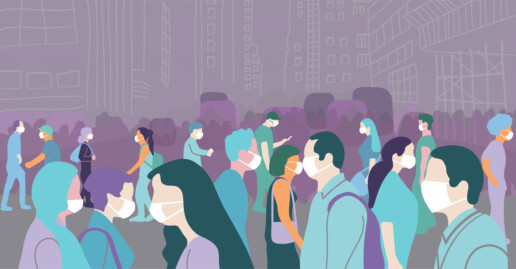Extracurricular Activity Participation Among JD Students
Although reading, class preparation, and classroom engagement are crucial to law student success, extracurricular activities provide unique experiences for hands-on learning and skill development. LSSSE asks about the activities in which law students have either already participated or plan to participate in the future. Which activities attract the most law students?
The majority of law students plan to complete a field placement (79%), engage in pro bono work or public service (74%), and join a law student organization (74%) before graduation. Around half of law students will be or already have been a law student organization leader, and around two in five are drawn to serving as a law journal member. However, students are somewhat less likely to include moot court and working with faculty members on research or committees in their extracurricular plans. Most law students do not plan to study abroad.
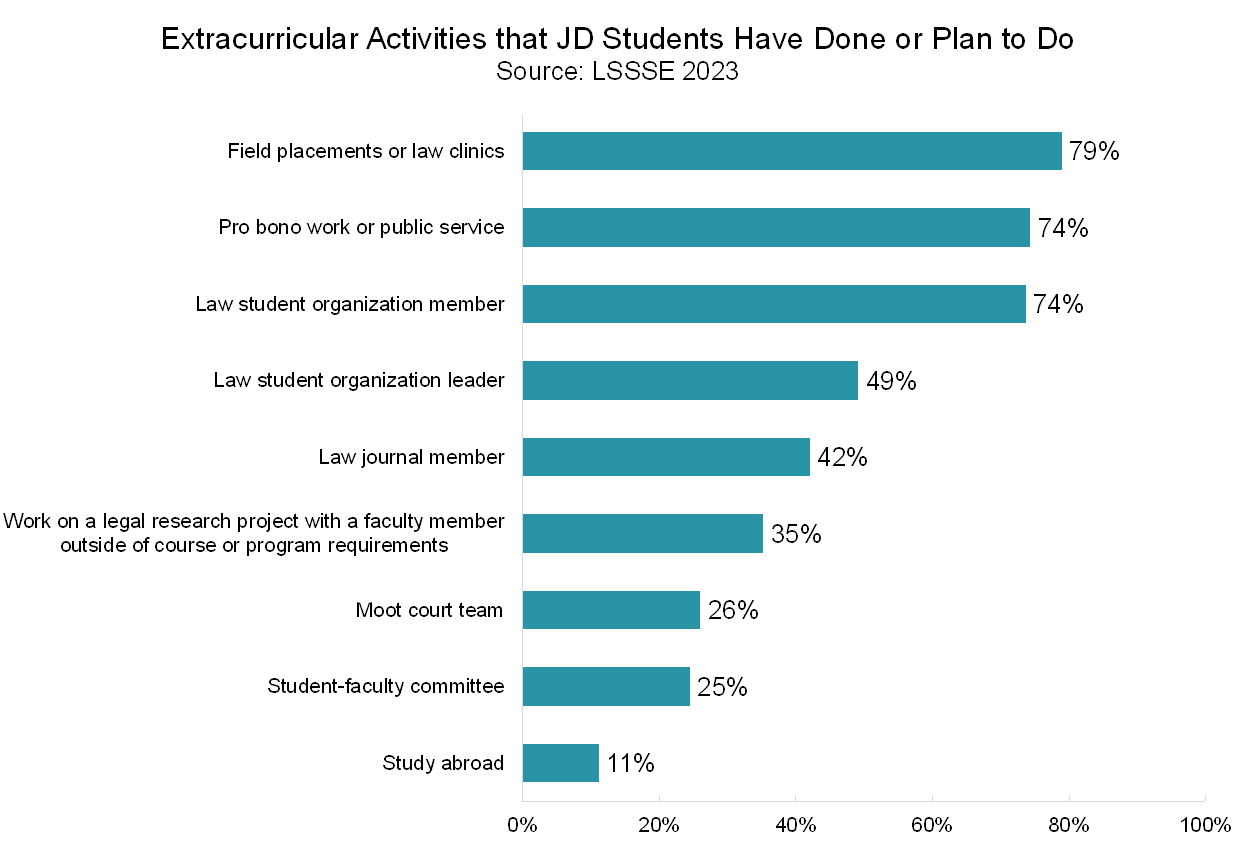
We know from previous LSSSE research that part-time students are somewhat less likely than their full-time classmates to engage in extracurricular activities. When we zoom in on part-time students specifically, which activities do they tend to make their highest priorities?
Field placements, pro bono work, and law student organization membership remain at the top of the list for part-time students. However, only about half of part-time students plan to join a student organization. Around a third (32%) of part-time students are interested in working on a legal research project, and around three in ten part-time students (29%) either have been or want to be a law journal member.
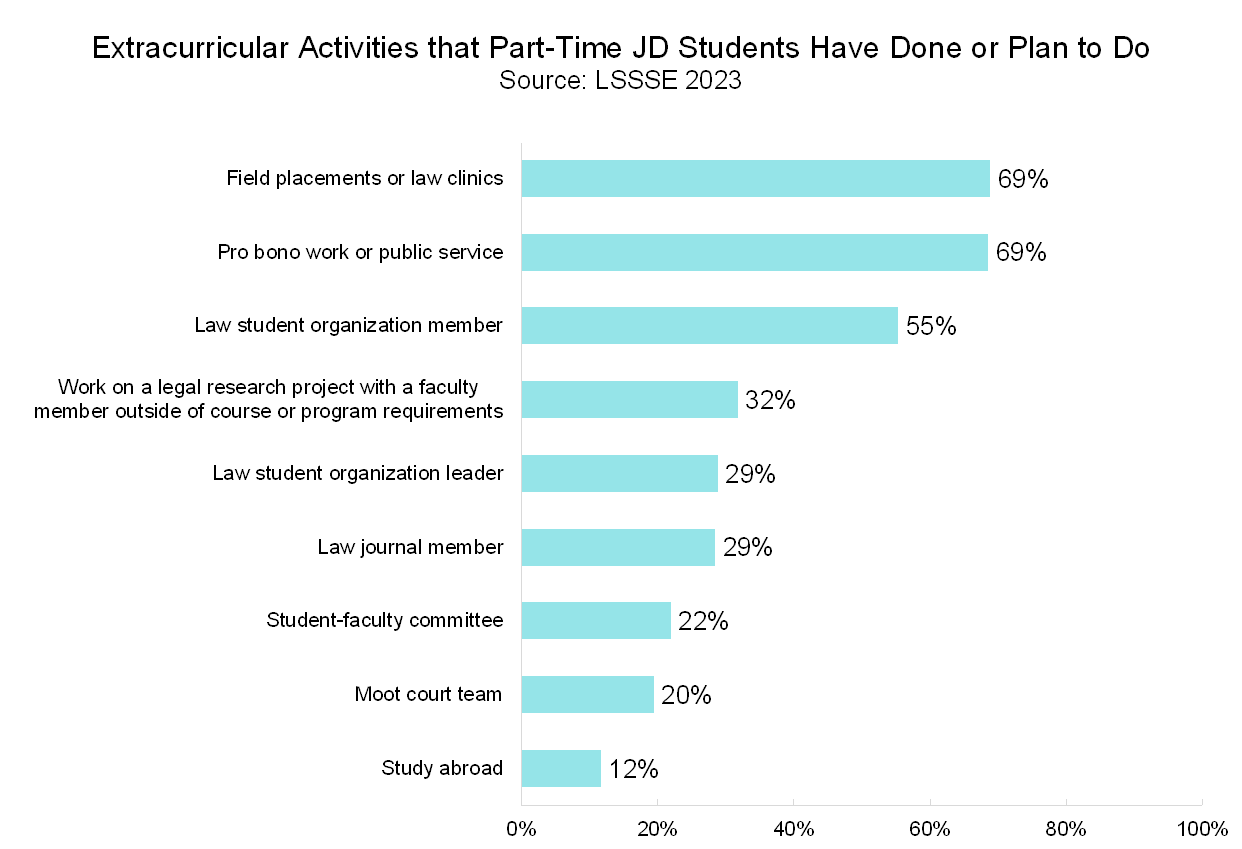
Clearly, being a law student is not a 9-5 endeavor. Most law students are engaged in a variety of activities beyond the bare minimum of class attendance and participation. These activities provide them with vital experiences and professional contacts that they will take forward into their legal careers.
Classroom participation by gender identity: 2023 update
In a 2018 blog post, we showed a long-standing pattern of class participation by gender among law students in which men engage more frequently in class discussions than women. Although the percentage of students who frequently ask questions in class or contribute to class discussions has fluctuated over time, the gap between men and women has stayed remarkably consistent since the inaugural LSSSE survey in 2004. How does this pattern look five years later?
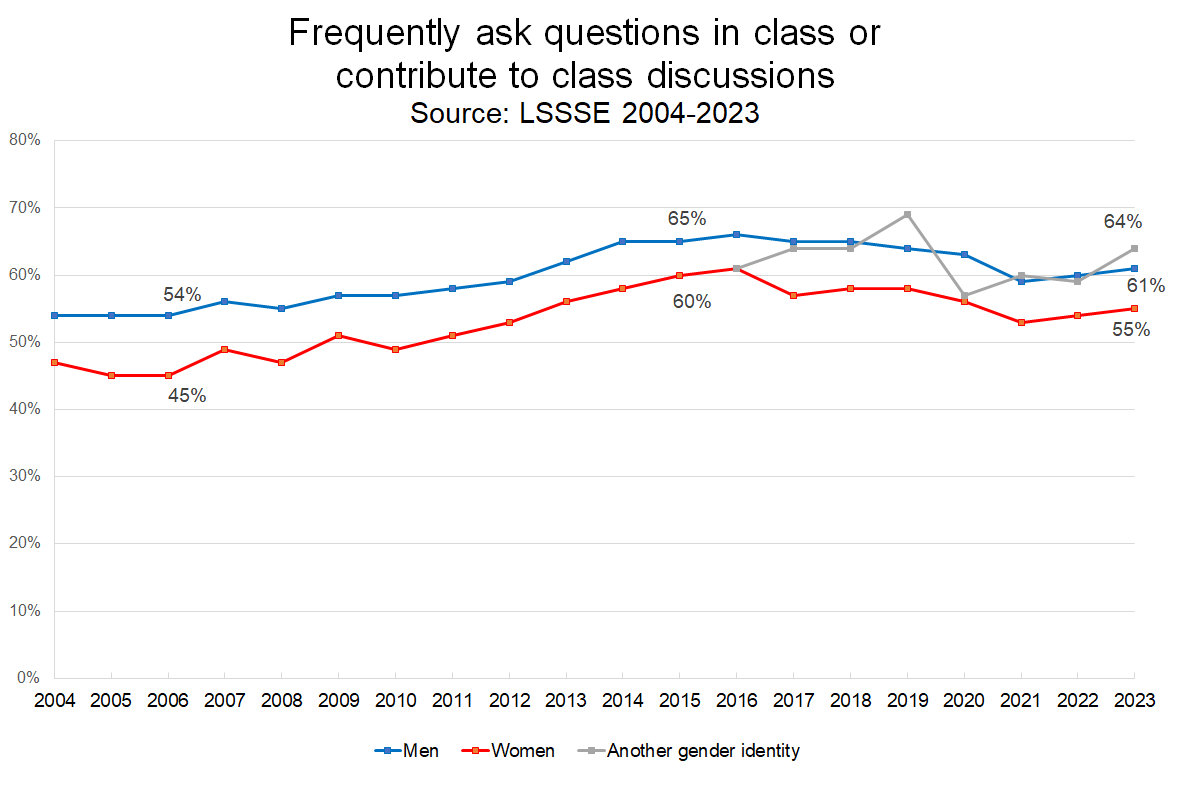
Through a pandemic, a switch to online learning, and a switch back to in-person learning, the pattern has continued to be remarkably consistent. In 2023, 61% of male law students “often” or “very often” participated in class compared to only 55% of female students. Students of another gender identity also generally participate in class more often than women, with nearly two-thirds (64%) of them frequently asking questions or contributing to class discussions in 2023.
However, it appears that there are differences among classes in terms of participation by gender. 1L women are much less likely than 1L students of other genders to frequently ask questions or contribute to discussions, but 3L women are only somewhat less likely to do so relative to 3L students of other genders. Perhaps women gain confidence across their years as a law student or perhaps they become major contributors to class discourse only once they can be reasonably sure that their voices will be heard and respected.
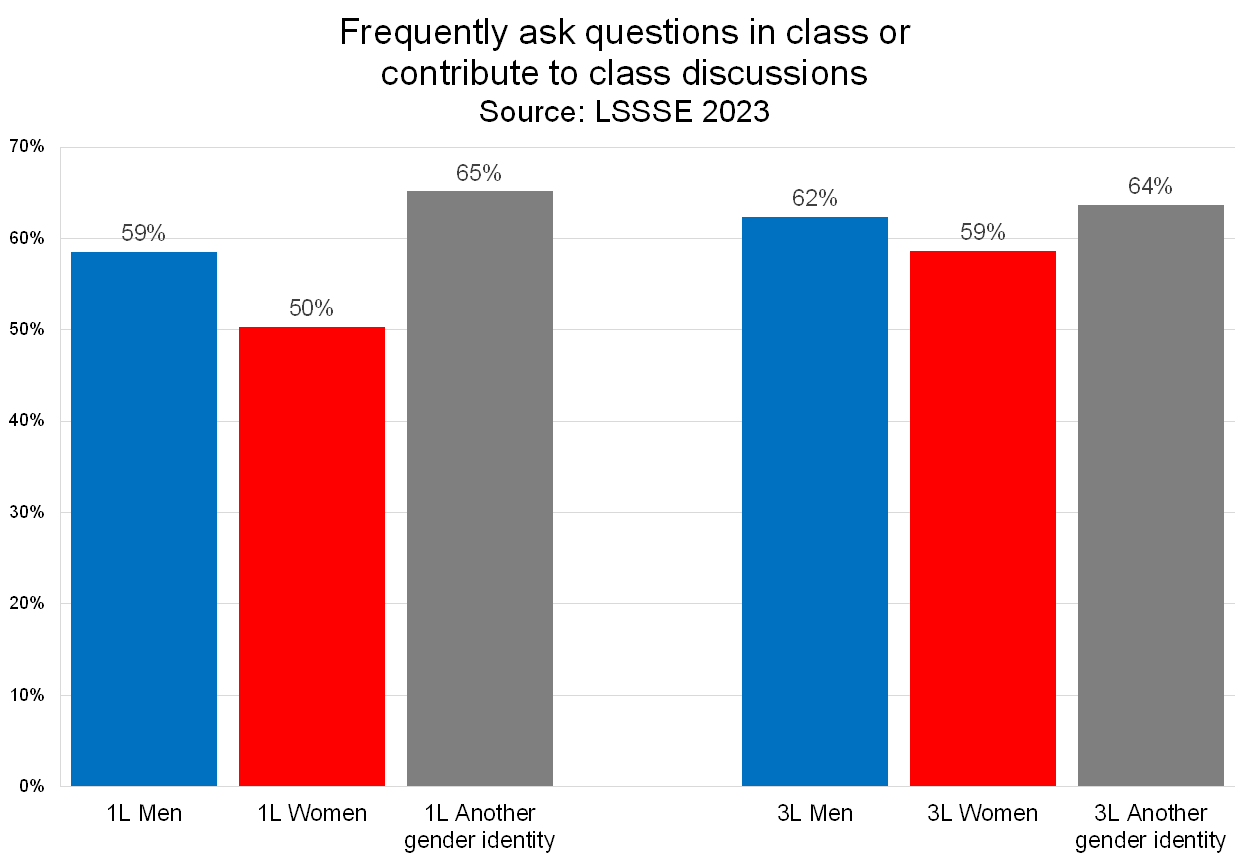
Nonetheless, men and people of other gender identities are still slightly more likely to frequently ask questions or contribute to discussions even in that final year of law school. Finding ways to encourage women to participate in class conversations earlier will allow them to engage more meaningfully with their entire legal education in addition to elevating the discourse of the law classroom for all students.
Part 1: Part-Time Students & the Law School Experience
Around 12% of law students attend part-time. This subpopulation of law students has a unique experience that differs from that of their full-time colleagues. In part one of this two-part series, we will explore the characteristics of part-time law students and describe some of the ways that they engage with the law school community and environment. In part two, we will look at how satisfied part-time students are with their law schools and the extent to which they feel supported in their success as students and as future legal professionals.
Part-time students tend to be somewhat older than their full-time classmates. Sixty percent of part-time students are over thirty years old compared to 14% of full-time students. In fact, one quarter (25%) of part-time students are over 40 compared to just 3% of full-time students. However, the proportions of men, women, and people of another gender identity are about equal between the two groups. Part-time students are more likely to be first generation (defined as a person whose parents did not graduate college) with over a third of part-timers (36%) falling into this category compared to only a quarter (25%) of full-timers. Part-time students are also more likely to be Black or Latinx.
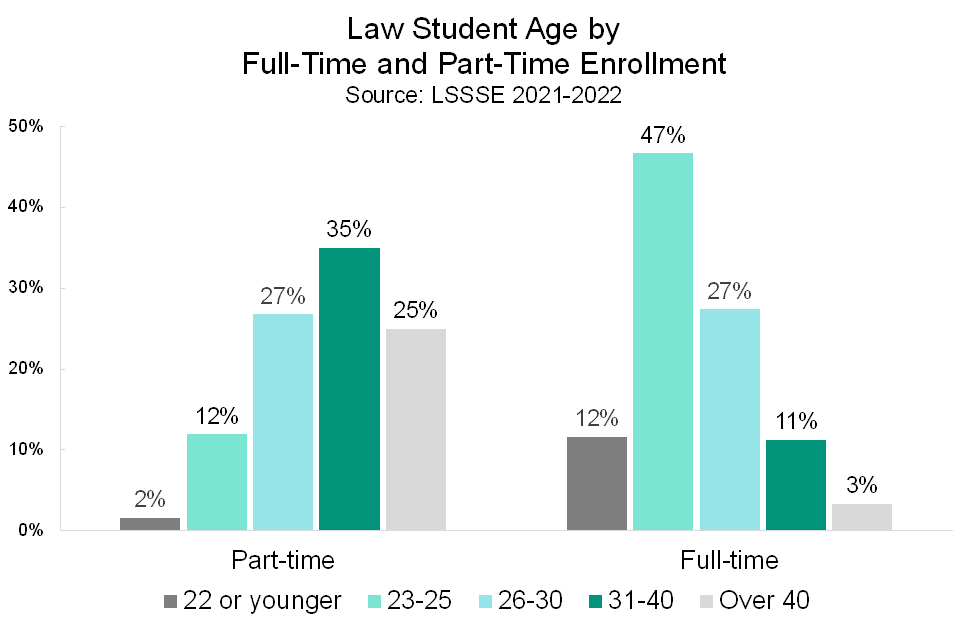

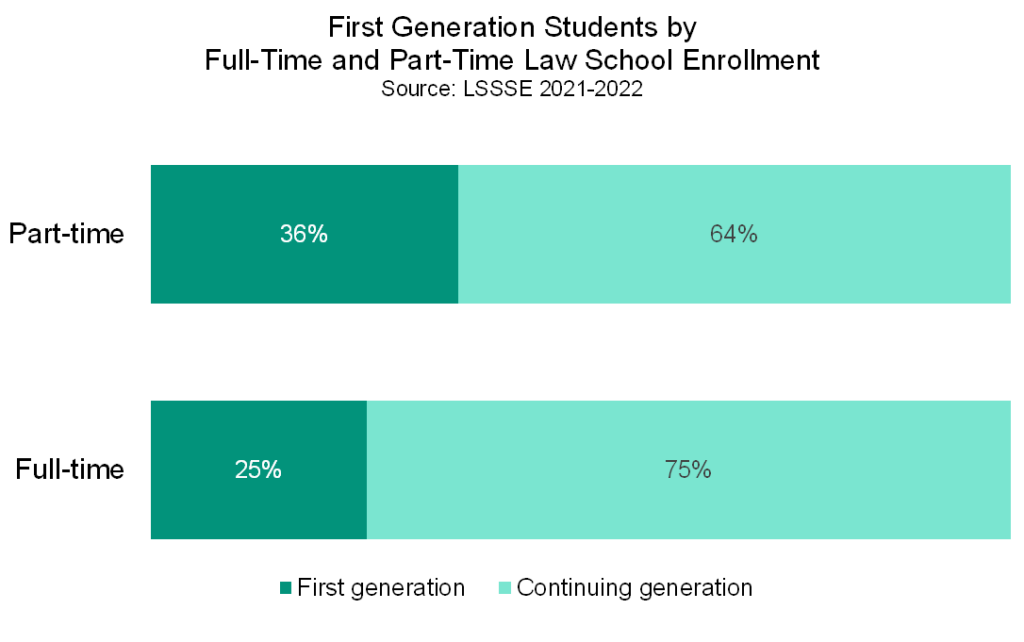

Part-time students are more likely than full-time students to expect to have no law school debt upon graduation, possibly because some part-time students are attending law school with the financial support of their employers. However, part-time students are also slightly more likely than full-time students to expect to owe more than $200,000, which is the highest debt category that LSSSE records. Seven percent of part-time students expect to owe this much compared to five percent of full-time students.
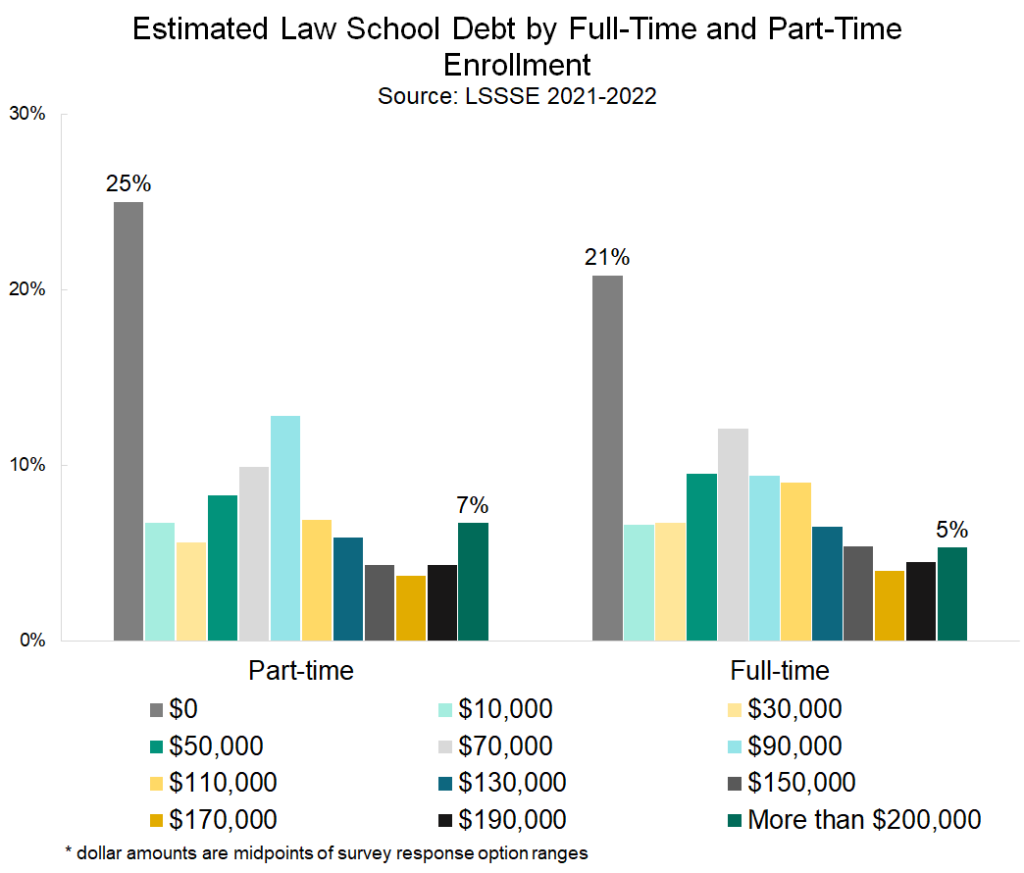
In terms of engagement with their coursework, more full-time students than part-time students frequently work with classmates outside of class to prepare class assignments. However, more part-time students frequently work with other students on projects during class time. Part-time students are somewhat less likely to engage in enriching experiences than their full-time counterparts, perhaps because they are more likely to have more intense work and family responsibilities. Still, about two-thirds (65%) of part-time students have completed or plan to participate in field placements and about two-thirds (67%) of part-time students have completed or plan to participate in public service. Additionally, over half (53%) of part-time students will join a law student organization before graduation. Part-time students are less likely than full-time students to partake in these opportunities, but their participation rates are still reasonably high given the other demands on their time.
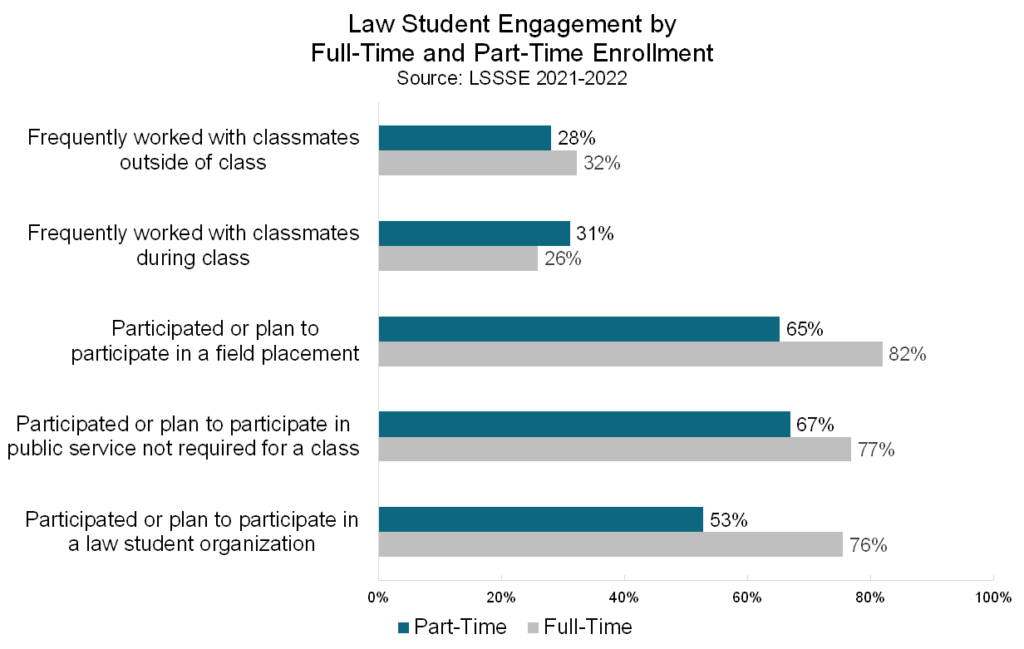
Part-time students find ways to make the law school experience their own. This group of students tends to be older and slightly more ethnically diverse, and they are somewhat less likely to add enriching law school experiences to their schedules. In our next post, we will examine part-time students’ feeling toward their law schools and the support they receive from faculty and administrators.
Engagement with Law Student Organizations
Law student organizations are important venues for developing law students’ professional identities. Through networking, invited speakers, and events, these organizations foster a sense of community and provide students the opportunity to more intensely explore areas of law that interest them. [1]
Law student organizations are among the most popular enriching activities at law schools. Nearly three-quarters (73%) of law students either plan to join a law student organization or have already done so. About 31% of students have served as law student organization leaders, and another 18% plan to take on a leadership role before they graduate. Men are less likely to join student organizations compared to women and those of another gender identity. In 2022, just 51% of men had already joined an organization compared to 64% of women and 75% of those with another gender identity.
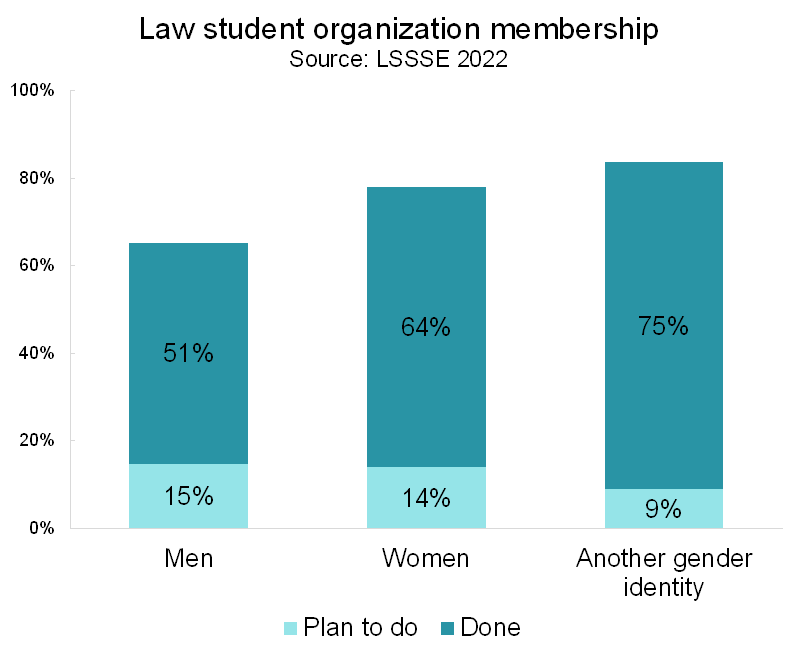
Black students are particularly engaged as members of law student organizations, with 65% of Black students participating and another 20% planning to do so. Native Hawaiian students, American Indian students, and Alaska Native students have similarly high levels of engagement with law student organizations, while Asian and white students have the lowest participation rates.

Women, gender-diverse people, and students of color are most likely to join student organizations. Thus, these organizations likely play a vital role in connecting law students who traditionally face higher barriers in accessing higher education and assimilating successfully into the legal profession. Law student organizations also given students the opportunity develop their leadership skills and to work with their professors and classmates in a non-classroom context.
____
[1] See Andrew Hitt, The importance of student organizations, (Aug. 27, 2009), https://law.marquette.edu/facultyblog/2009/08/the-importance-of-student-organizations/
Relationships with Law Faculty
Law students generally have strong relationships with law school faculty members. In 2022, 71% of LSSSE respondents ranked their relationships with faculty a 5 or higher on a 7-point scale, where 7 represents faculty who are “available, helpful, and sympathetic.” Only 12% of students ranked their relationships a 3 or lower, and a mere 1% of students ranked their relationships a 1, meaning they feel that the faculty at their law school are “unavailable, unhelpful, and unsympathetic.”
Relationships with instructors are built both inside and outside the classroom. More than half (53%) of law students discussed assignments with a faculty member often or very often, and only 5% never discussed assignments with a faculty member. After completing assignments, most law students (91%) receive prompt feedback from faculty on their academic performance at least sometimes. However, only 13% say they receive prompt feedback very often, and 9% never receive prompt feedback.
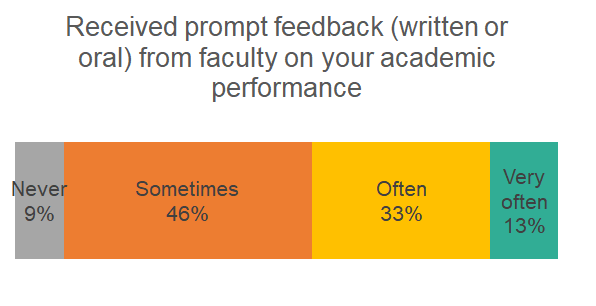
About one in five students (21%) often or very often discussed ideas from their readings or classes with faculty members outside of class, and another half (50%) did so sometimes. This practice tapers off a bit over time, with 22% of first-year students discussing ideas with faculty members outside of class often or very often compared to 19% of 3Ls and 11% of 4Ls.
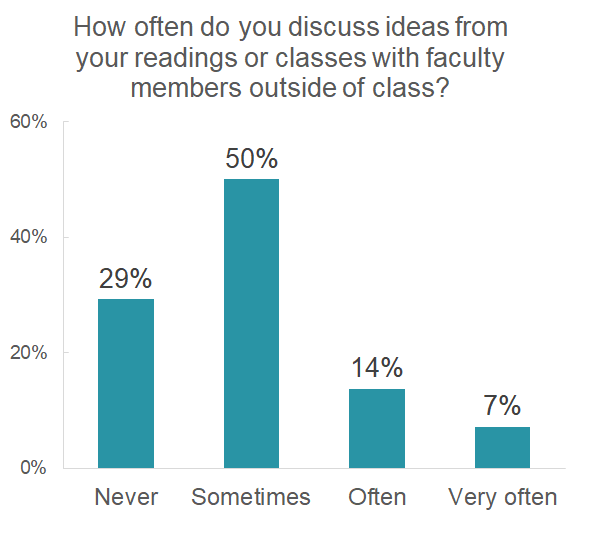
Law school faculty can provide crucial guidance about navigating the legal job market, and the vast majority of students (84%) take advantage of their advice. Just over a third of students (36%) discuss their career plans or job search activities with a faculty member of advisor often or very often. Around 82% of first-generation students (neither parent holds a bachelor’s degree) have discussed their career plans with faculty compared to 85% of their non-first-generation peers.
The relationships students form during their time in law school can be crucial to their future success. The majority of law students make the most of these relationships, and they appreciate the support and knowledge they receive from the faculty of their law schools.
New Questions Focusing on Law Students with Disabilities
By popular demand, LSSSE is now capturing information about the experience of law students with disabilities. Law students are given the opportunity to select one or more conditions using the following questions:
Have you been diagnosed with any disability or impairment?
- Yes
- No
- I prefer not to respond
Which of the following impacts your learning, working, or living activities?
- Sensory disability
- Blind or low vision
- Deaf or hard of hearing
- Physical disability
- Mobility condition that affects walking
- Mobility condition that does not affect walking
- Speech or communication disorder
- Traumatic or acquired brain injury
- Mental health or developmental disability
- Anxiety
- Attention deficit or hyperactivity disorder (ADD or ADHD)
- Autism spectrum
- Depression
- Another mental health or developmental disability (schizophrenia, eating disorder, etc.)
- Another disability or condition
- Chronic medical condition (asthma, diabetes, Crohn’s disease, etc.)
- Learning disability
- Intellectual disability
- Disability or condition not listed
- Please describe your disability or condition
In 2022, nearly one in five (19%) of LSSSE respondents had a disability. Students who responded "yes" to the disability question then had the option to select the condition(s) that impact their learning, working or living activities. Mental health conditions were by far the most common, with about 13% of law students having a condition such as anxiety, ADHD, or autism. Four percent of law students had a condition not specified on the survey such as a chronic health condition or a learning disability. Two percent of respondents had a physical disability, and one percent had a sensory disability such as being deaf or hard of hearing.
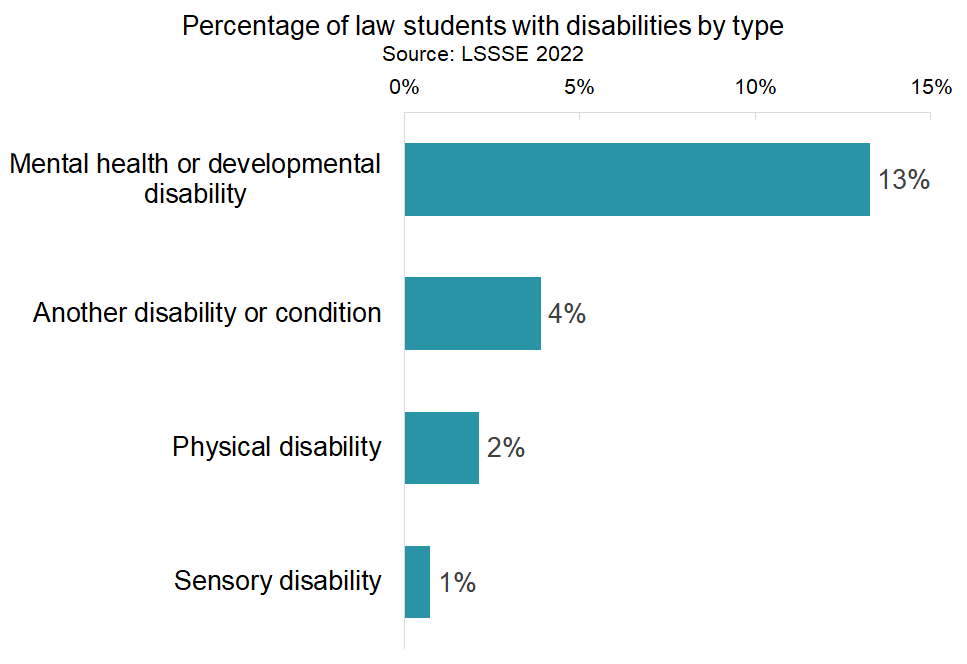
In addition to tracking the overall proportion of law students who are disabled, these new data give us an exciting opportunity to explore how students with disabilities might engage differently with their law schools and what particular experiences or services law schools can offer to better help these students succeed as professionals. For example, law students who have a disability are more likely to participate in class discussions, both online and in person, compared to their non-disabled peers. Additionally, students with disabilities are more likely to engage in pro bono work or public service during law school. Near four out of five students with disabilities (79%) either plan to or have done pro bono work or public service compared to 74% of non-disabled students.
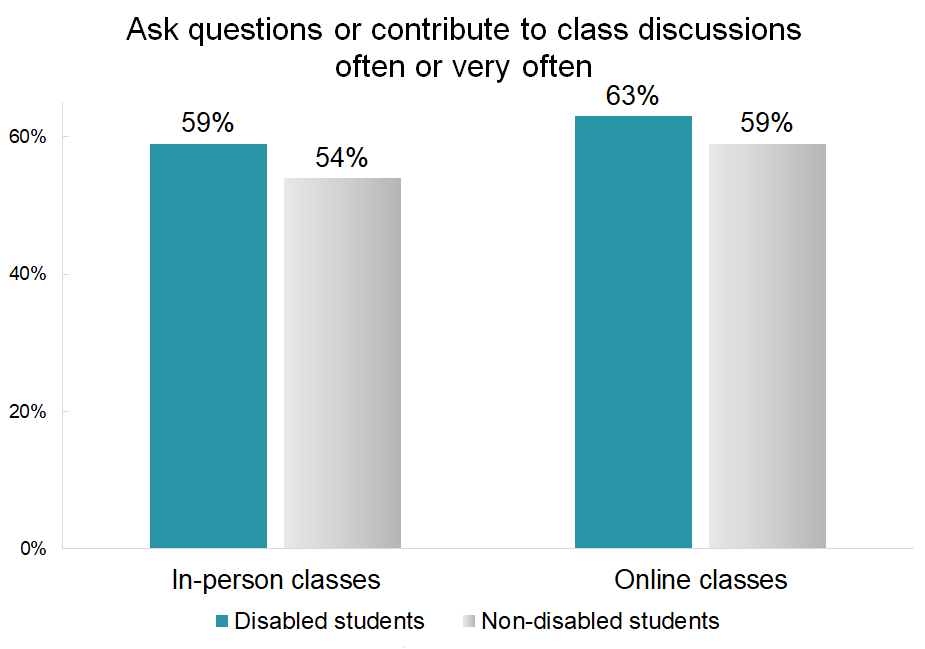
However, disabled students are less likely to be satisfied with their experiences with academic advising and career advising compared to their classmates. This suggests that law students with disabilities engage intensely with the law school experience but do not always feel as supported as their non-disabled peers.
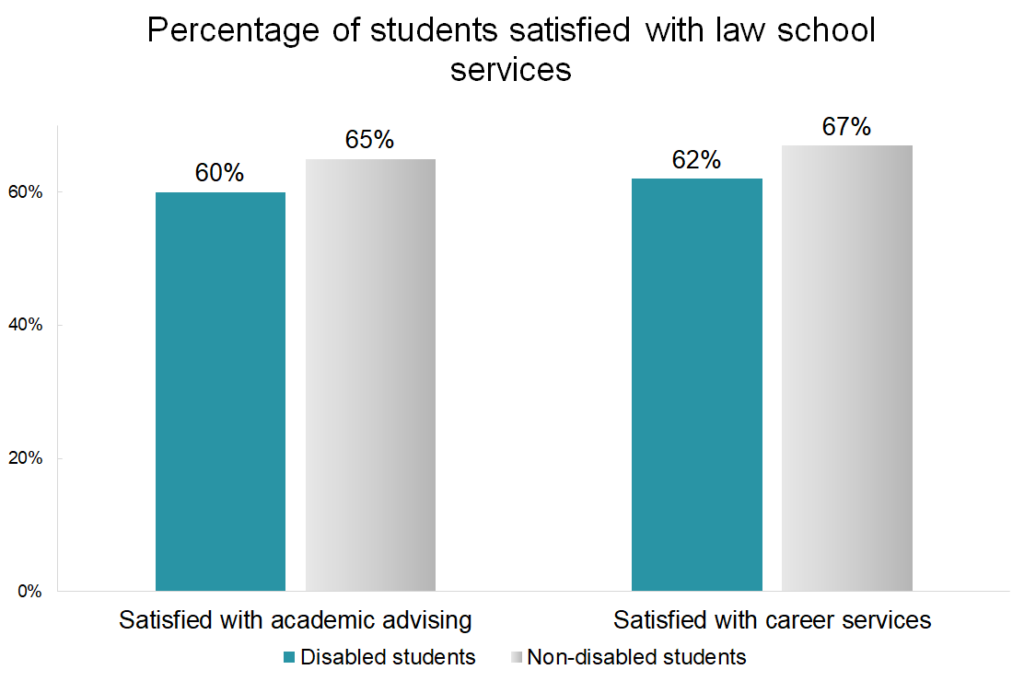
The new disability questions are included in the core LSSSE survey and available to all participating law schools. Survey registration will be opening soon; contact LSSSE for more details!
Online Learning and Law Student Age
The 2020-2021 academic year was unlike any other, forcing students and instructors to adapt to a different way of living and learning. Prior to the pandemic, law schools were less likely than other sectors of academia to embrace online learning. But when it became clear that COVID was not going away, many law schools shifted to primarily online interactions. The Online Learning module, which debuted with the spring 2021 LSSSE survey administration, was developed to capture students’ perceptions and experiences with online classes during this peculiar academic year and potentially beyond. Although the abruptness of the transition to online learning and the external stressors inherent to pandemic life may make these data unique in some ways, in other ways they are an excellent starting point for law schools to learn about how to structure their curriculum to leverage the strengths of the online environment, even as traditional in-person learning resumes.
What types of online learning experiences were law students having in 2020-2021? Nearly all students who took online courses had at least some synchronous element in their courses. Nearly two-thirds of students typically had synchronous courses while another third experienced a mixture of synchronous and asynchronous content. Only about two percent of students typically received only asynchronous content.
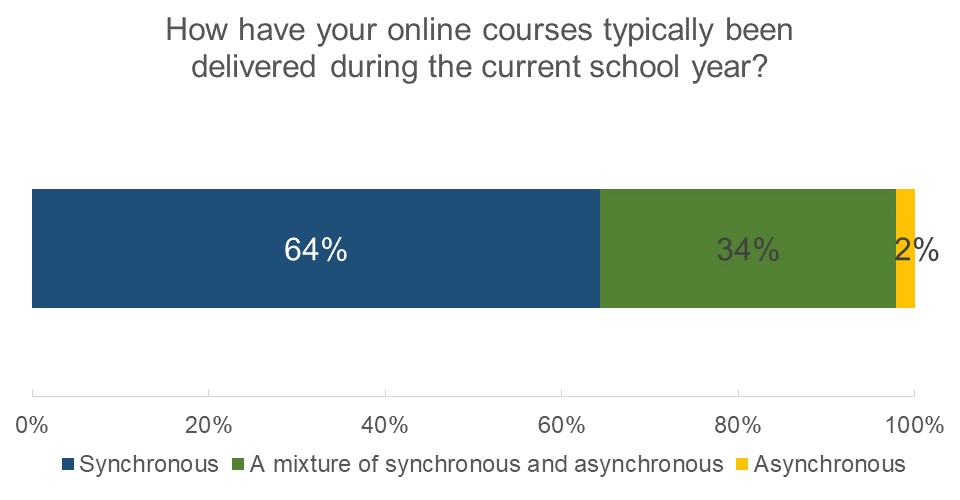
Most law students were fairly comfortable with online learning. Seventy percent of students were mostly comfortable or very comfortable interacting with the instructor of their online courses, and around 65% felt similarly about interacting with the other students. About two-thirds of students were comfortable with online discussion tools such as discussion boards and forums and about two-thirds of students were comfortable with live online course discussions.

Interestingly, older students were more likely to be comfortable with virtually all aspects of online learning relative to their younger peers. In fact, comfort with online learning tools increased steadily across age brackets. The vast majority (86%) of students over 40 were comfortable participating in live online discussions compared to only around 62% of students 25 or younger.

This age discrepancy in participation exists in physical classrooms too. In 2019, before the widespread adoption of online law classes, 80% of students over age 40 often or very often asked questions in class or contributed to class discussions, compared to 48% of those 22 or younger and 54% of those between 23 and 25. In fact, students under age 30 may be somewhat more comfortable with online course discussions than in-person ones, even though their overall participation is less than that of their older classmates regardless of the class setting.

Older students were also more likely to be comfortable interacting with their peers and instructors online. Only 63% of students age 22 or younger were comfortable interacting with their instructors online, compared to a full 85% of students over 40. Among students between the ages of 23 and 25 (the most common age for a law student), less than two-thirds were comfortable interacting with other students in their online classes, compared to a full 78% of students over 40.

Although popular media tends to suggest that younger people are more adept with technology, the oldest Millennials – the first generation to live much of their lives online – are now in their forties. Perhaps these older students have adapted to so much online technology across their personal and professional lives that another pivot was not as disruptive as it was for their younger colleagues. Regardless of the reason, the LSSSE data show clearly that law schools should make a deliberate effort to support the technological skills and online engagement levels of their youngest students.
Part 1: The COVID Crisis in Legal Education: Impact on Core Mission and Enriching Experiences
Because LSSSE has been annually administered since 2004, the survey was well-positioned to capture shifts in students’ perceptions and behaviors during the uniquely challenging 2020-2021 academic year. Our 2021 Annual Results, The COVID Crisis in Legal Education (pdf) draws from the core survey and two new modules (“Coping with COVID” and “Experiences with Online Learning”) to identify key struggles and successes of legal education during a period marked by uncertainty and disruption.
In the midst of a challenging year, some positives emerge from the data. Overall satisfaction remained high throughout legal education and comparable to past years. A full 78% of students in 2021 rated their entire educational experience in law school as “good” or “excellent,” which is similar to rates from recent years (82% in 2018, and 81% in 2019 and 2020). This is a testament to the significant efforts of faculty, staff, and administrators who pivoted to meet student needs as well as to the resiliency of the students themselves.
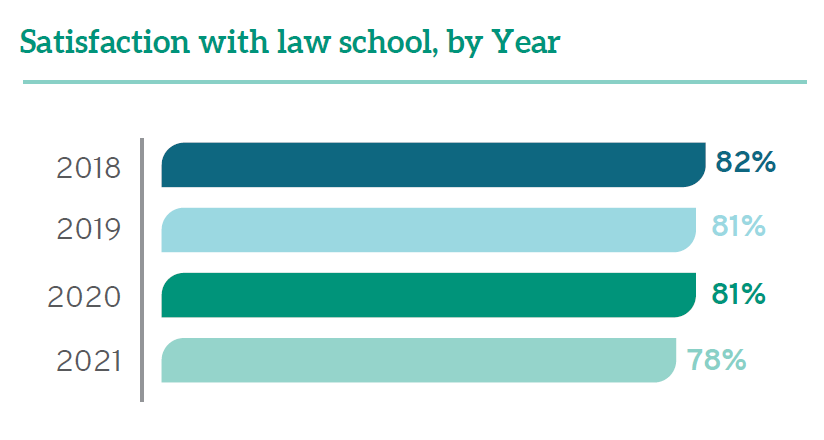
Nevertheless, the ability to forge and foster relationships has been especially difficult during the pandemic, which is borne out in the data. The percentage of students reporting positive relationships with staff dropped from 68% in 2018 to 59% in 2021—the lowest percentage recorded since LSSSE began collecting data on student-staff interactions in 2004. During those same years, positive student relationships with faculty and fellow students dropped just slightly from 76% to 72% and 76% to 73%, respectively. A full 93% of students appreciated that their law professors showed “care and concern for students” as the pandemic raged around them. First-year students were less likely to report positive relationships than 2Ls and 3Ls—likely because upper-class students could build on foundations they had cemented pre-COVID while 1Ls were attempting to start relationships from scratch in the midst of the pandemic.
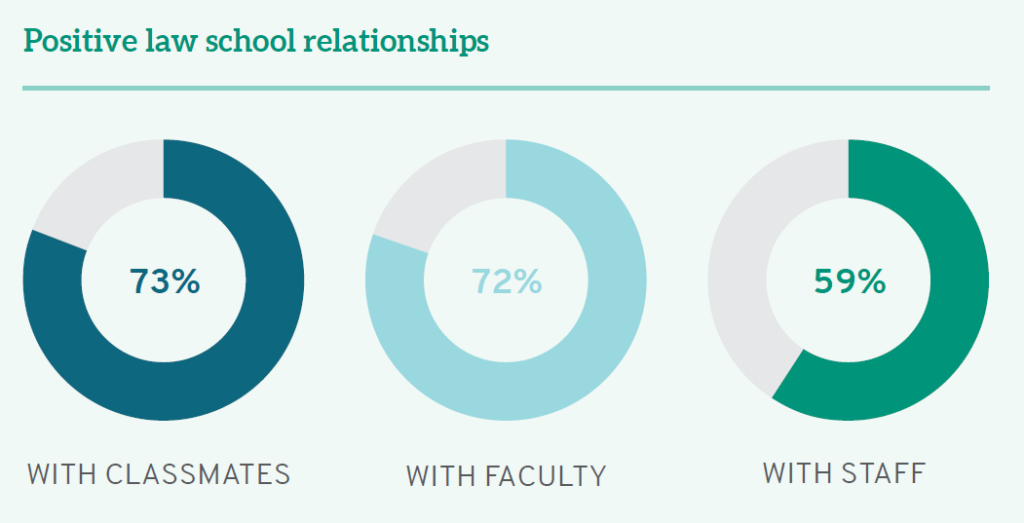
The core of legal education remains relatively unchanged. Every year from 2018 to 2021, 85% of students have acknowledged that their schools contributed “quite a bit” or “very much” to their ability to acquire a broad legal education. There were also minimal changes this year compared to years past with regard to students developing legal research skills (80- 83%) and learning effectively on their own (81-82%).
Yet the intangibles of legal education were significantly affected by COVID-19, with potential negative consequences on the professional competency of these future lawyers. A full 90% of students noted that COVID interfered with their ability to participate in special learning opportunities, including study abroad, internships, and other field placements. While discussions about course assignments and faculty feedback on academic performance remained constant, just one-third (33%) of all law students found frequent occasions to talk with faculty members or other advisors about career plans or the job search process (down from 40% in 2018), and only 19% frequently discussed ideas from readings or classes with faculty members outside of class (down from 25% in 2018). There were also fewer opportunities for students to work with faculty members on activities other than coursework.
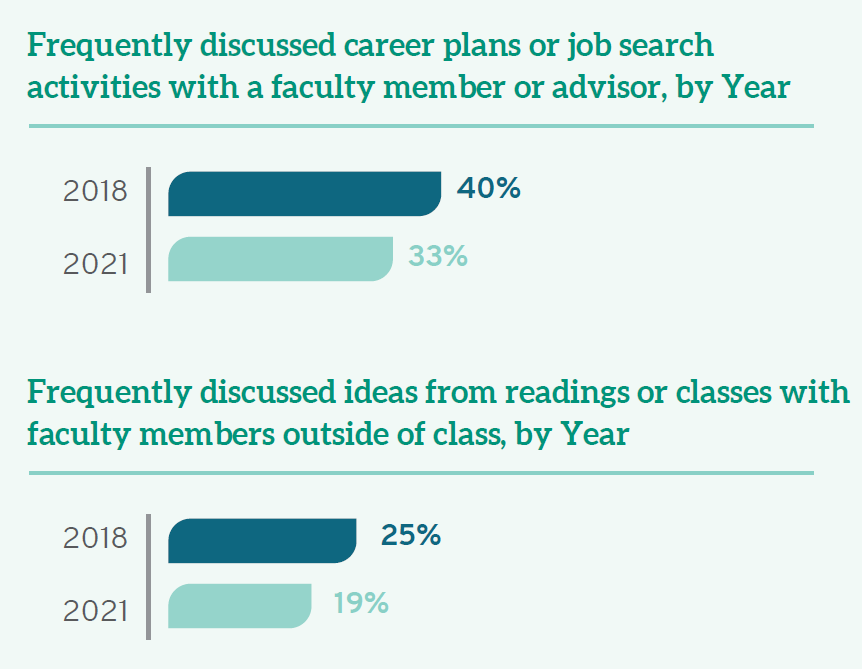
The COVID-19 pandemic has disrupted nearly all aspects of life, and law school is no exception. Although law schools did their best to continue on with the education of the next generation of lawyers, there were still marked decreases in student engagement, particularly in building relationships and gaining experience outside the classroom. In our next post, we will explore the areas in which law students struggled the most in their lives and show how the pandemic disproportionately impacted those students who were already the most vulnerable.
Knowledge, Skills, and Personal Development in Law School
What does one learn in law school? In this post, we describe the areas of academic, professional, and personal development that graduating law students feel were most strongly influenced by their law school experience.
Students nearing graduation (full-time 3L students and part-time 4L students) in 2020 were most likely to say that they developed “very much” in terms of their ability to think critically and analytically (49%) and in acquiring a broad legal education (46%). Research, writing, and speaking skills were also key areas of academic and personal growth. Fewer students responded that they developed “very much” in interpersonal skills such as working effectively with others (19%) and understanding people who are different from themselves (17%).
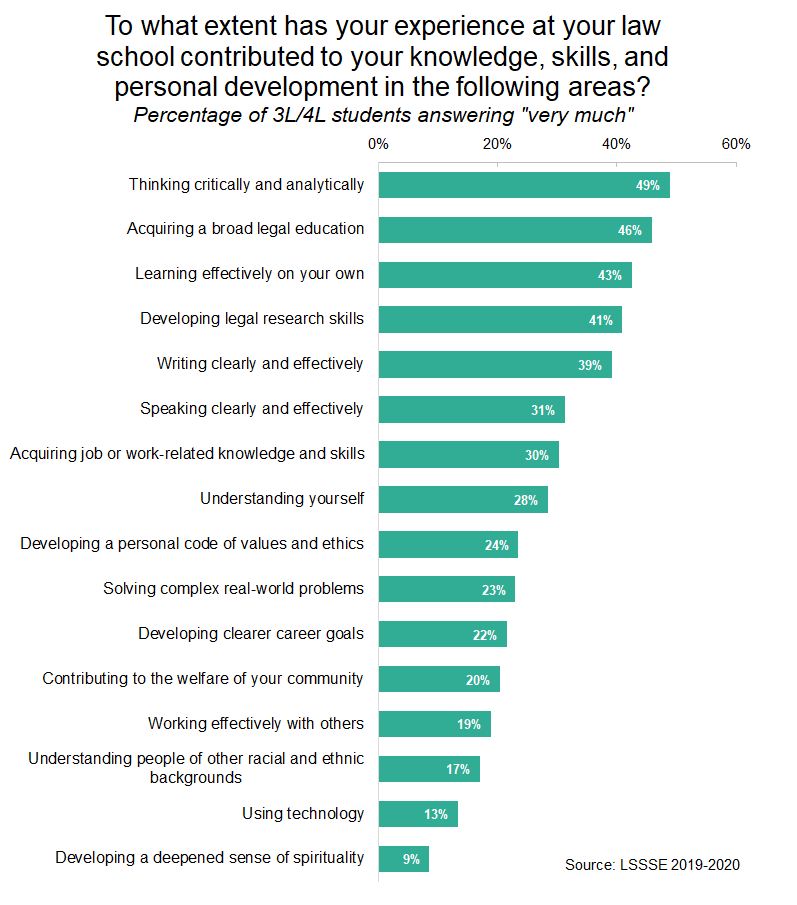
From 2005 to the present, graduating law students have been remarkably consistent in the areas in which they say they have developed the most. Between 40% and 50% of law students over the last fifteen years feel they have acquired a broad legal education and learned how to learn effectively on their own. However, only around 20% of law students felt they had learned very much both about solving complex real-world problems and about developing clearer career goals, although these numbers have climbed over time. In terms of personal development and community values, usually about three in ten graduating students say they have made “very much” progress in understanding themselves, but only between 10% and 20% of students have made similar gains in understanding people of other racial and ethnic backgrounds. However, this area of interpersonal development has also increased noticeably over the last fifteen years.
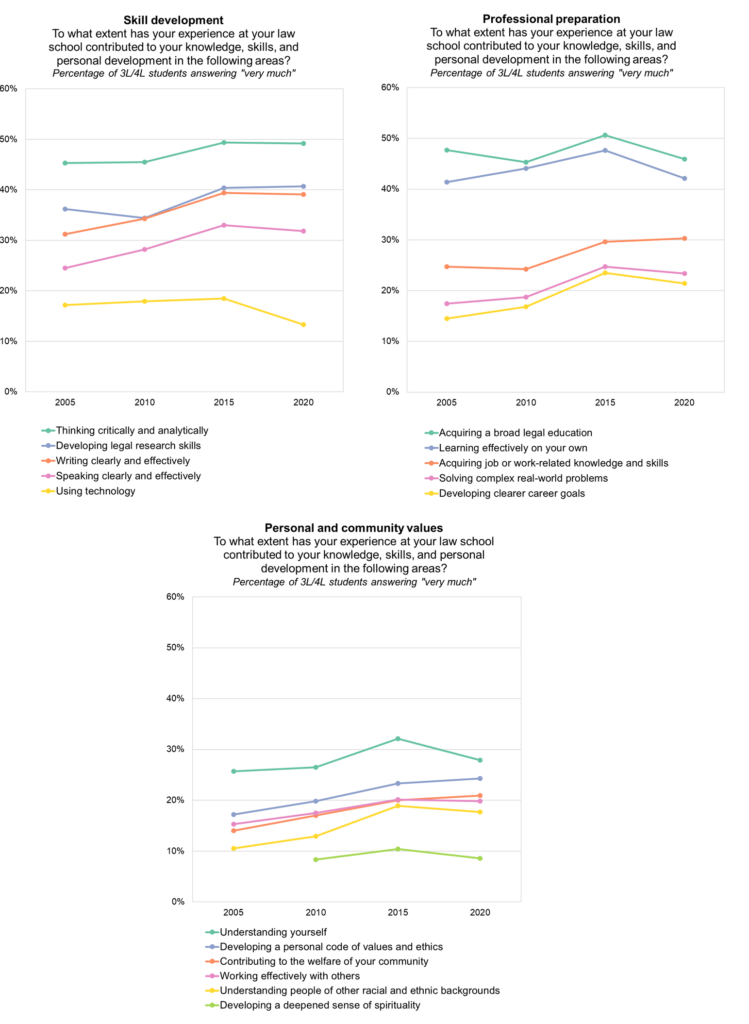
What Do 1L Students Plan to Do in Law School?
Most students complete law school in three years. With intense coursework and notoriously challenging reading loads, law students must be selective about how they allocate their time toward extracurricular activities. Which enriching activities had 1L students completed or planned to complete before graduation in 2019 and 2020? Check out our interactive visualization below to see.
** Note that non-binary students are included only when the population was large enough to ensure student anonymity in aggregate reporting.








